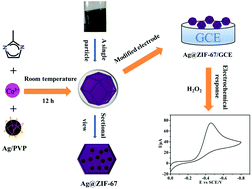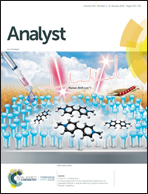Preparation of Ag@zeolitic imidazolate framework-67 at room temperature for electrochemical sensing of hydrogen peroxide†
Abstract
In this work, a novel non-enzymatic hydrogen peroxide sensor, Ag@zeolitic imidazolate framework-67 (Ag@ZIF-67)/glassy carbon electrode (GCE), was fabricated by a simple method at room temperature. The morphology and structure of Ag@ZIF-67 were investigated by scanning electron microscopy, transmission electron microscopy, energy dispersive spectroscopy, Fourier transform infrared spectroscopy, powder X-ray diffraction, atomic absorption spectrophotometry, and N2 absorption isotherms, which indicated that core–shell Ag@ZIF-67 was successfully synthesized with a porous rhombic dodecahedron structure. Electrochemical investigations demonstrated that the Ag@ZIF-67/GCE had strong electrocatalytic activity towards hydrogen peroxide reduction with a low detection limit of 1.5 μM (S/N = 3), a fast response time of 3 s, and three different linear relationships in the ranges of 5.0 μM–275 μM, 775 μM–2775 μM, and 4775 μM–16 775 μM with sensitivities of 27 μA mM−1 cm−2, 13 μA mM−1 cm−2, and 5.3 μA mM−1 cm−2, respectively. Moreover, the fabricated sensor exhibited an excellent recovery rate in real sample analysis of medical hydrogen peroxide disinfectant. These results proved that Ag@ZIF-67/GCE is an effective electrochemical sensor for detecting hydrogen peroxide.



 Please wait while we load your content...
Please wait while we load your content...